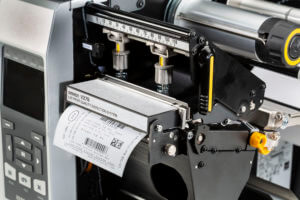A multinational medical device contract manufacturer of stents, balloons and catheters needed to be able to easily shift manufacturing lines across its multiple facilities from development to mass production. Each facility was doing the same type of work, and it was necessary to maintain precision and accuracy as demand increased. The customer is opening a new R&D facility that will function as a prototype location for building a “Golden” manufacturing line as well as a space to be used to manage temporary production increases.
The customer reached out to Omron for a solution that would help with speed and consistency in labeling across its many facilities. Label accuracy is imperative in the medical device industry, as any incorrect information can lead to fines, recalls and a reduction in consumer confidence. In order to comply with FDA UDI standards, all medical device manufacturers are required to format their labels in a specific way so that end users can easily identify package contents. This includes a unique device identifier (UDI) that must be issued through an FDA-accredited agency.
A multinational medical device contract manufacturer needed to improve labeling speed and accuracy as demand increased across its several facilities.
The customer replaced time-consuming manual inspections with the LVS-7510 Series printer-integrated label inspection solution from Omron.
The customer was able to get the system up and running very quickly, allowing two operators who had previously been working on label inspection to focus on other tasks.

Omron sold the medical device manufacturer an LVS-7510 system with specifications fitting the exact customer need. The system creates templates for each requisite label format that can then be saved in the cloud and accessed across all facilities. This helps transitions from one facility to another flow seamlessly and guarantees that every label produced meets a global standard created by a team of experts in these regulations.
Omron has worked with the world’s leading printer manufacturer to create the LVS-75xx Series printer-integrated label inspection solution, which is the only barcode quality grading system compatible with Zebra thermal printers that complies with ISO 15426 and GS1 standards. With inspection reports for 100% of produced labels, users can be assured that full compliance with regulations is achieved and that no products are shipped with defective labels.
Prior to investing in a new in-line label inspection system from Omron, the medical device manufacturer had its employees perform inspections manually. Two people would be required to visually inspect each label for accuracy and print quality. This process involved not only the human-readable information on the label, but also the automatic identification portion (essentially, the information contained in the barcode).
The FDA UDI mandate also requires barcodes to be of a certain quality threshold to help ensure that they will be readable throughout the supply chain. Any barcode reader can validate whether a code is readable, but simple validation isn’t enough to guarantee a passing grade. It’s possible to grade barcodes manually if volumes are small and the inspection team is well trained on the changing standards, but it becomes unmanageable once manufacturing starts being moved between facilities for a larger variety of products that each have unique requirements.
Removing inspection-related decisions from floor-level employees has resulted in less mandatory training on individual standards as jobs change. Thanks to the solution’s light stack and visual UI that alert operators when direct attention is needed, a single employee can either run multiple systems at once or focus on other operations in the manufacturing line. Omron also provided an IQ/OQ/PQ package to help users get up and running quickly with the system, saving the customer what could have been months of work.
The customer was able to immediately implement the system and begin designing label templates for their other locations. Two operators who had been working on label instruction were able to move their focus to other tasks, and the concern about faulty labels is much diminished. The manufacturer will continue to implement this solution across its multiple facilities as well as other contract manufacturing sites.
REFERENCES
“Traceability Life Sciences Success Story”, Omron Automation, 3/2/2021

Be the first to learn about classes, training, webinars, products news and more.
We use only necessary cookies on this website to provide the best user experience and customer service.